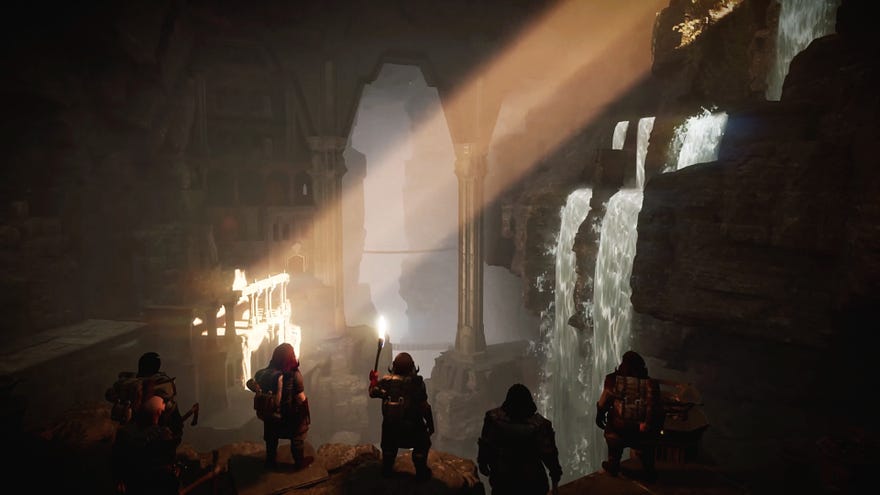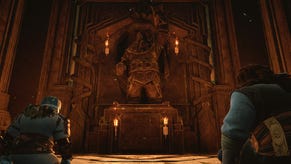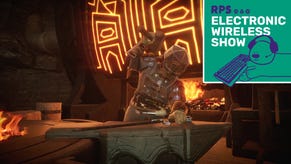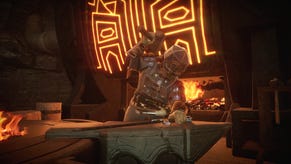Return To Moria isn't an amazing game, but it takes you to an amazing place
My cousin Balin will give us a royal welcome
I'm braving the long dark of Moria, and the major dilemma at present is that I can't line up my feasting table with my hearthfire. In Free Range Games's plucky dungeon sim The Lord of the Rings: Return to Moria, you're a dwarf trying to reclaim the once-proud undercity of Khazad-dûm, tunnelling between procedurally generated networks of halls and crafting your own havens and upgrade facilities from long-wrecked forges and mansions.
The game is set after Sauron's defeat at the end of The Return of the King novel (spoilers, I guess?), at a time in Middle-earth canon when most of the big names were busy shaking hands and doling out promotions, but there are still plenty of orcs, trolls and other threats to worry about in Moria. Right now, though, the real headache is that I can't make my base of operations symmetrical.
The building palette spins objects by right-angles, and in the case of my current dwelling (an otherwise attractive cottage below a gap in the cavern roof where I can grow onions in the pale Hithaeglirian sun), the templates cut diagonally across the floor. This may be due to my own ineptitude, or it could be the result of a disagreement between the construction editor and the procgen. Either way, it's vexing. If I want to graft a door to the house, it appears I'll need to fashion a weird, italicised porch extension. And they call it a mine!


Mileages may vary, but I struggle to feel at home when I'm building at 45 degrees to the world. Mind you, you're not really supposed to feel at home in Moria. It's the quintessential dungeon in western genre fantasy, the primordial abyss lurking below the catacombs of storyworlds like Elder Scrolls and D&D. And building quirks aside, I'm enjoying Free Range Games's interpretation of the place, which is extensively researched and, if you come to it fresh from the Peter Jackson movies, surprisingly varied.
You've got your classic endless, pillared halls where the torchlight lingers over arrow-stuck piles of armour and picks out flecks of coal in surfaces that can be excavated. But then you burrow through one of those diggable walls (in multiplayer, there's a lovely mechanic where you can have your character sing in harmony with other players during mining) and emerge into an underground forest beneath a larger tear in the roof.
There are traces of Elven architecture here, marks of a long-ago collaboration with the rulers of fallen Eregion - spiral-carved pillars leading the way to grander forges with missing components. There are also a lot of angry badger-type creatures, and some really heavy-footed wolves (the game's audio cues are a bit overcompensatory, but in Free Range's defence, you spend a lot of time circumventing threats in the dark). Elsewhere, you'll venture into abandoned dwarven towns with square courtyards and breweries where huge copper stills slumber like dragons. Are there any actual dragons down here? I can't speak to the canonicity of that idea, but I wouldn't be surprised.
Moria isn't just a set of spaces, of course. It's a story about avarice and transfiguration. The dwarves dug too greedily and too deep, as we know. The books present Moria as a literal reflection of their self-destructive hunger for gold, jewels and mithril: among its major landmarks is Mirrormere, a lake in whose surface Khazad-dûm's founder, Durin, once glimpsed a crown of stars. But Moria is also a catalyst for transformation and rebirth: Gandalf the Grey becomes Gandalf the White after fighting the Balrog and plummeting into the waters at the Black Chasm's base.

Tolkien scholars call this the "tomb to womb" arc, apparently, which - urgh, thanks lads. I'm interested to see how Free Range handle these ideas in the context of another kind of arc, the routine video game loop of looting and mining and crafting and upgrading. Video games know a thing or two about digging too greedily and too deep, though they seldom really punish you for doing so. One of the original roguelikes was 1983's The Dungeons of Moria, which was also the first roguelike to feature a town level. That town-and-dungeon roguelike framework was a huge influence on Blizzard's Diablo games, which have turned the act of drilling down and waking the Balrog into a game-as-a-service.
Lots to ponder there! But before I can sink my teeth into such questions I need to get my chairs and tables squared off correctly, sow my onions and see about patching that roof before the goblins sneak in. I'm not handling our Return to Moria review - these thoughts are the result of me helping Alice B test out the co-op, by which I mean that I obsessively tried to Feng Shui all her outposts while she politely asked me to accompany her on various story quests. But I can see myself playing this to completion, both out of curiosity about the remaining biomes and to think about parallels between Moria and the many subterranean video game spaces that feel like extensions of Moria, lurking on the other side of the next cavern wall - the sunken laboratories of GTFO, the shaking passageways of Amnesia: The Bunker and the ASCII labyrinths of the greatest Moria homage of all, Dwarf Fortress.















